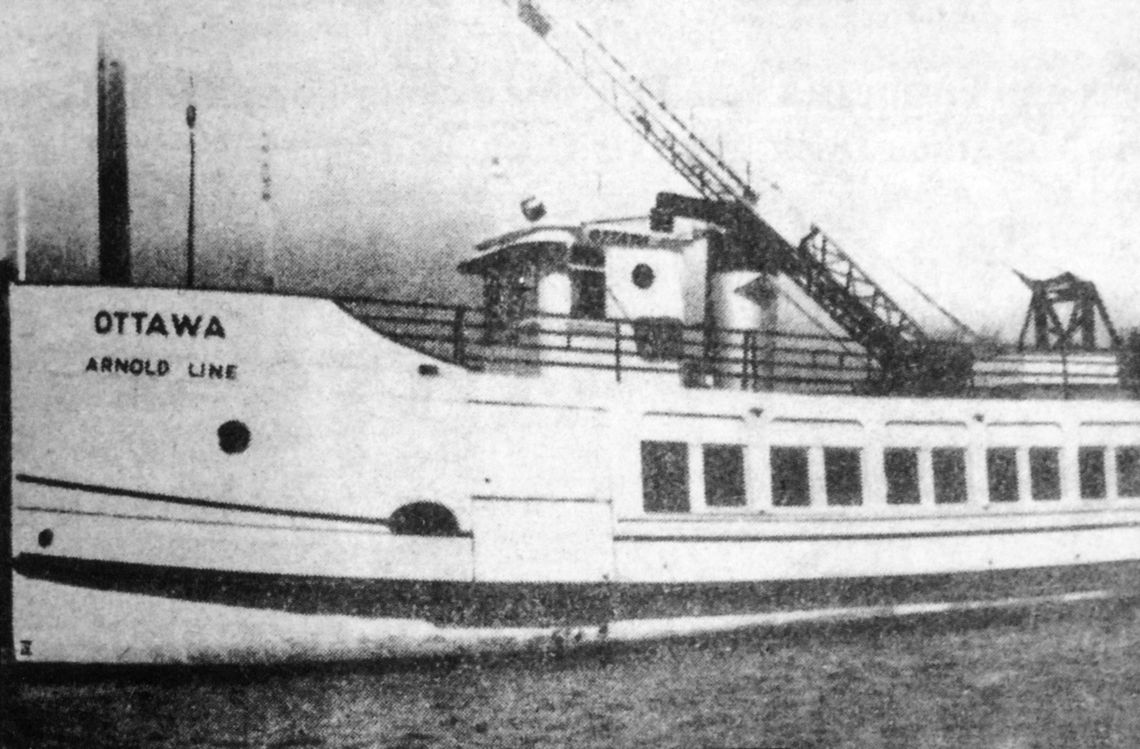The following is an excerpt from “Meet Me At The Dock in Greilickville, Grand Traverse Bay” by author Kathleen Firestone.
Copies of her books are available at local book stores or directly from her.
Traverse residents and businesses also began using coal for heating and the running of machinery. Until 1950 this need for coal kept many lake fleets busy hauling coal from eastern states. Salt and sand were also carried by these freighters and unloaded in Greilickville and other ports, for use on winter roads.
Three main docks were established along the bay in Greilickville: the Sears/Burke Dock to the north, Standard Oil/Rennie/Marathon Dock to the south, and Sinclair Dock in the middle. These docks have become landmarks in the descriptions and stories of Greilickville.
Sears-Burke Dock Franklin Sears was founder and owners of Sears Marine Construction Company, using his commercial barges, tugboats and other equipment.
In the 1930s Sears constructed a coal dock in Greilickville, to aid in the supply of coal for local residents and businesses. For about 20 years, Sears and other employees supervised the unloading of coal at his dock, and his small office sat along the shoreline.
Jack Burke leased the dock in November, 1951, and it gained the name Burke Coal Dock. Burke also purchased a coal dock in Suttons Bay, in 1957. A Burke Coal Dock was not a brand new idea from Jack Burke. The Burke name had a long history with the coal industry, beginning in Ireland and Australia. The extended Burke family, with its Burke Coal Company, operated mines in Appalachia and distributed coal throughout the Midwest. Ohio, New York, Pennsylvania, Iowa and Indiana all had Burke offices managed by Burke family members.
Simeon S. Burke of Chicago was part owner of Northern Michigan Transportation Company for a time and bought the steamer Lawrence from D.H. Day of Glen Haven. The Lawrence became a common sight on Grand Traverse Bay.
Frank Sears continued to have barges and tugs at the shoreside part of the local Burke dock, for use in his marine construction work. One tug was the Ottawa, which was formerly operated by Arnold Transit at Mackinaw. Sears did marine construction projects around Grand Traverse Bay, at Northport Point, and across Lake Michigan. Sears died in 1971.
At Burke’s Coal Dock, selfunloaders brought tons of coal to the area for winter hearing and for the fueling of manufacturing. The Sears/Burke Dock had a storage capacity of 18,000 tons. Any size vessel could dock, but maximum draft had to be considered.
On the Great Lakes scene, bulk carriers moved 8,907,663 tons of coal in the year 1900. The peak was reached in 1948 with 60,0563,530 tons, and the amount tapered down to 37,993,533 by 1990.
Is it a railroad company or a steamship company? In 1892 Francis H. Clergue had a vision of Sault Ste. Marie becoming an industrial center and her was there to help make it happen. He developed 12 enterprises, including a steel mill, pulp mill, several mining operations, utility companies, and two railways. His Algoma Central and Algoma Eastern Railways soon added a fleet of steamships that operated on the Great Lakes. In 1901, the railway became Algoma Central & Hudson Bay Railway Company, and in 1965, it changed again, to Algoma Central Corporation.
Standard Oil/Rennie Dock The Standard Oil Dock was built in Greilickville during the 1930s by Sears Marine Construction Company, and oil products were unloaded from ships of the Socony fleet. Cleveland Oil Company also brought products to this oil dock.
Standard Oil had built the world’s largest refinery in 1889, at Whiting, Indiana. As aftereff ect of the 1911 government break-up of Standard Oil, in 1931 Socony merged with Vacuum Oil to form Socony-Vacuum (Standard Oil Company of New York) became incorporated in 1934. A division of Socony became Mobil Oil in 1920, with the symbol of the Pegasus. When television came to Northern Michigan in the 1950s, viewers in the Leelanau and Grand Traverse areas watched local news interrupted with “flying, red horse” commercials.
Mobil Oil and six sister companies dominated the global petroleum industry from the mid-1940s to the 1970s.
Mobil was the largest seller of gasoline and motor oils in the United States during many of those years. (In 1999 Exxon Corporation merged with Mobil Corporation and took the brand name of Exxon Mobil.)
W.L. Faust, vie president of Socony-Vacuum Oil Company, authorized attorneys H.J. Miller and H.M. Sullivan of Detroit to act on behalf of Socony in business matters in Michigan, as of May 15, 1947.
That’s the era when the Standard Oil Dock in Greilickville transitioned in name to Rennie Dock.
The Rennie family had come to this area when William Rennie first entered Grand Traverse Bay in 1851, as part of the crew of timber speculator Perry Hannah. Charles Rennie, Sr., was William Rennie’s son. Rennie Oil Company was founded by Charles Rennie and began with a gas station at the northwest corner of State and Union Streets in Traverse City, around 1920. This was only about 15 years after the first gasoline auto had been delivered to Traverse City.
Charles Rennie’s gas station was recognized as the “Pioneer Station of the North.” At first, gasoline was delivered to his station by railroad. Rennie began delivering to other gas stations in Leelanau and Grand Traverse, as more and more people owned cars, trucks and gas-powered equipment.
Charles Rennie always sought to expand his oil distribution business. Through mortgages Rennie Oil Company gained property from W.V. Butler for Government Lot 3, Section 33, Town 28, in Elmwood Township, for $38,000, beginning June 20 and Nov. 19, 1934.
A later quiet title was claimed by Rennie, which included this and other nearby property. Rennie was preparing for the day when he could operate his own oil dock in Greilickville.
With the help of Socony’s Detroit lawyers, Charles Rennie worked out a purchase a agreement for the Standard Oil Dock in Greilickville, around 1947. Charles Rennie wanted to make improvements for a bigger and better Standard/Rennie Dock and his son, Charles Rennie. Jr. , who had become vice president of Rennie Oil Company, agreed.
Editor’s note: This article is running again with corrections.








